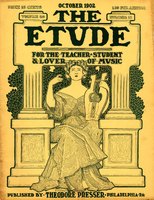The Fourteenth Caprice.
Special study of the E-flat minor scale should precede the study of this Caprice. Pupils will always find it desirable, if not absolutely necessary, to devote much attention to the scale corresponding to the key of the Caprice. And this is more especially applicable to the Caprices written in more than either three sharps or three flats.
The tempo-mark given in my edition for the introductory Adagio is 72 quarters. This is a trifle too fast. The character of these opening measures demands a slower, statelier tempo: about 60 quarters rather than 72. For the last quarter of the 5th measure the bow should be raised from the string and brought back to the point. This enables the player to employ the entire length of the bow, and contributes to breadth and freedom of style. The same principle of bowing applies to similar figures in the 6th and 7th measures. The episode which begins on the 2d quarter of the 14th measure should be played more fluently, but not in a restless or hurried manner. The player must avoid giving prominence to the upper B-flat of the 15th and 16th measures, and the upper F of the 17th measure. There is always some temptation to accent upper tones, but to do so is obviously destructive of proportion and musical meaning.
Long strokes, and an exceedingly supple wrist, are naturally the first requirements of the Appassionato. The lower part of the bow requires special attention; and most players will find that they shun the lower eighth, thus destroying all possibility of developing strength and agility at the “heel.”
The trills present a twofold difficulty: technical mastery and musical fidelity. All require slow and patient work in order ultimately to play them clearly, rapidly, and brilliantly. But after digital mastery has been achieved it will generally be found that most of the trills leave something to be desired. Careful scrutiny will reveal the fact that the trill is begun a trifle too soon—a digital eagerness which results in a depreciation of the time-value of the preceding note.
The accent, which characterizes the whole Appassionato, is too often exaggerated. It should be gently coaxed from the instrument, not produced in a harsh or explosive manner.
The Fifteenth Caprice.
This is one of Rode’s most admirable studies for wrist and forearm development. It should be played at the upper part of the bow, and the pupil should not attempt to play it rapidly until much careful work has been done in a slow tempo. The difficulties for the left hand are easily understood by most players, and their mastery requires only the usual toil and persistence. But it is quite a different matter with the right arm. The average student’s attention is riveted on the wrist, and the important work of loosening the elbow receives either little or no attention.
Unfortunately, so far as this analysis is concerned, little practical help can be offered the pupil by a mere description of the forearm stroke necessary for the successful performance of this Caprice. In many cases the wrist may prove to be insufficient; but the majority of players will probably discover that the forearm is, in a certain respect, less capable than the wrist. That is, it will be found that the movement of the forearm lacks freedom on account of a stubborn elbow which persists in forcing activity of the upper arm. Such activity, it is needless to say, is detrimental to good bowing; and every possible effort should be made to develop independence of the forearm to such a degree that, practically, the upper arm takes no part in bowing of any kind.
But this question of an inactive upper arm is too easily misunderstood. The average pupil will exclaim, in astonishment: “Why, every violinist moves his upper arm!” This is certainly true; but (and this is what inexperienced players fail to comprehend) there is a vast difference between compulsory action of the upper arm and that action which is an attempt to perform the work assigned to the forearm and the wrist. In other words, an immovable upper arm is a physical impossibility, more especially in crossing the strings. But this does not mean that the upper arm performs, or actually takes part in the performance of, the various bowings. It inevitably follows the direction of the forearm and wrist; but no demands should be made upon it, nor should it, at any time, be actively engaged in the technics of the right arm.
(To be continued.)



